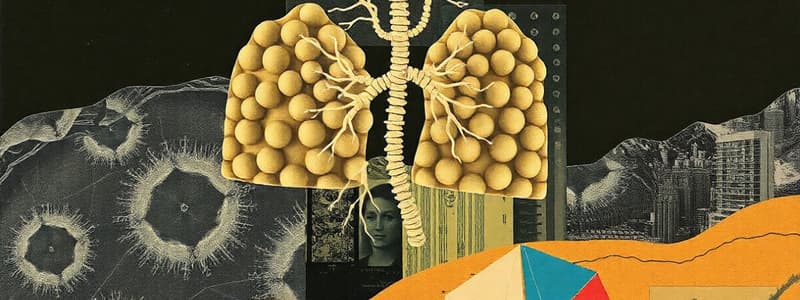Podcast
Questions and Answers
What is the primary function of energy within a cell?
What is the primary function of energy within a cell?
- To store genetic information
- To facilitate the transport of proteins
- To maintain structural integrity of the cell
- To drive cellular activities and processes (correct)
How do cells typically organize biomolecules?
How do cells typically organize biomolecules?
- By randomly distributing them throughout the cell
- By forming specialized compartments and structures (correct)
- By breaking them down into smaller fragments
- By aggregating all biomolecules into a single structure
Which of the following describes how information is transferred within cells?
Which of the following describes how information is transferred within cells?
- Through passive diffusion of molecules
- By utilizing chemical signals and pathways (correct)
- Through direct contact between cell membranes
- Exclusively using electrical impulses
What role do biomolecules play in cellular activities?
What role do biomolecules play in cellular activities?
Which mechanism is NOT involved in the organization of biomolecules?
Which mechanism is NOT involved in the organization of biomolecules?
What is the disaccharide formed from two glucose molecules?
What is the disaccharide formed from two glucose molecules?
Which two monosaccharides combine to form sucrose?
Which two monosaccharides combine to form sucrose?
Which disaccharide is known to contain glucose and galactose?
Which disaccharide is known to contain glucose and galactose?
What is one of the uses of maltose mentioned?
What is one of the uses of maltose mentioned?
Which of the following is NOT a disaccharide?
Which of the following is NOT a disaccharide?
What are cerebrosides classified as?
What are cerebrosides classified as?
What is one of the functions of glycolipids?
What is one of the functions of glycolipids?
Which statement is true regarding glycolipids?
Which statement is true regarding glycolipids?
Which of the following is NOT a function of glycolipids?
Which of the following is NOT a function of glycolipids?
What type of lipids are glycolipids classified as?
What type of lipids are glycolipids classified as?
What structural form does DNA take?
What structural form does DNA take?
What is a key feature of DNA regarding its replication?
What is a key feature of DNA regarding its replication?
What role does DNA play in the development of proteins?
What role does DNA play in the development of proteins?
How is DNA transmitted between generations?
How is DNA transmitted between generations?
Which of these statements about DNA is false?
Which of these statements about DNA is false?
What characteristic makes steroids classified as lipids?
What characteristic makes steroids classified as lipids?
Which of the following is NOT true about steroids?
Which of the following is NOT true about steroids?
Which substance is included in the classification of lipids due to its properties?
Which substance is included in the classification of lipids due to its properties?
What distinguishes steroids from other lipids?
What distinguishes steroids from other lipids?
Which statement accurately describes the composition of steroids?
Which statement accurately describes the composition of steroids?
Study Notes
Energy Production and Usage in Cells
- Cells store energy in chemical bonds within molecules like glucose and fatty acids.
- Energy is released through the breakdown of these molecules, a process called cellular respiration.
- This energy is then used to power various cellular activities like:
- Movement: muscle contraction
- Synthesis: building new molecules
- Transport: moving substances across membranes
- Communication: sending signals between cells
- Cells have mechanisms to store and release energy efficiently.
Cellular Organization and Biomolecule Coordination
- Cells organize biomolecules into structures like organelles and membranes.
- This allows for the highly coordinated and efficient execution of cellular processes.
- Organelles, specialized structures within cells, have specific functions and are interconnected for optimal operation.
- Membrane-bound compartments help to regulate internal environments and facilitate specific reactions.
Information Transfer Mechanisms in Cells
- Cells transfer information using various mechanisms:
- DNA replication: Copying of the DNA molecule for cell division and inheritance.
- Transcription: DNA information is transcribed into a messenger RNA (mRNA) molecule.
- Translation: mRNA is used as a template to synthesize proteins.
- Signal transduction: Cells communicate using signaling molecules that bind to receptors and trigger responses.
Disaccharides and their Uses
- Disaccharides are composed of two monosaccharide units linked together.
- Maltose is formed from two glucose molecules and can be obtained from starch breakdown.
- Sucrose is composed of glucose and fructose and is commonly known as table sugar.
- Lactose is made up of glucose and galactose and is found in dairy products.
- Maltose is used in dialysis solutions as it can be converted from icodextrin.
Glycolipids and their Functions
- Glycolipids are complex lipids with carbohydrate components.
- Glycolipids play structural roles as components of the plasma membrane, influencing cell-cell interactions and recognition.
- Glycolipids are also involved in blood group determination, contributing to the individuality of blood types.
Complex Lipids and Steroids
- Complex lipids are diverse in structure and function, including glycolipids and phospholipids.
- Steroids are not strictly lipids but are included due to their fat-like properties.
- Steroids lack fatty acids but have important functions, including serving as hormones and forming the cell membrane structure.
- Terpenes are another type of complex lipid with various roles, including pigments and vitamins.
DNA: Deoxyribonucleic Acid
- DNA is a double-stranded molecule that forms a helix.
- It has the unique ability to self-replicate, ensuring accurate transmission of genetic information during cell division.
- DNA contains genes, which are regions of DNA that code for specific proteins.
- These genes are inherited from one generation to the next, passing along traits and characteristics.
Studying That Suits You
Use AI to generate personalized quizzes and flashcards to suit your learning preferences.
Related Documents
Description
Explore the processes of energy production and usage in cells, including cellular respiration and the role of biomolecules. This quiz will cover how cells organize their internal structures to carry out essential functions like movement, synthesis, and communication effectively.




